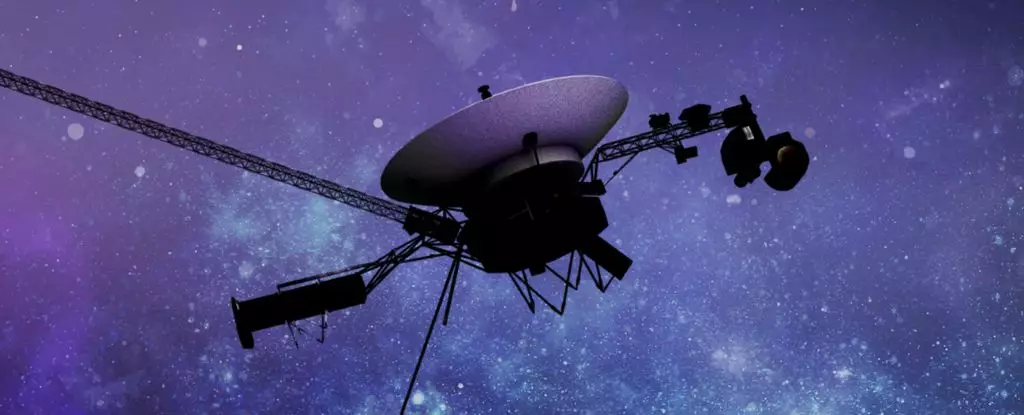Voyager 1, the most distant human-made object from Earth, continues to captivate scientists and the public alike with its long-standing mission through the vast expanses of interstellar space. Recently, the spacecraft experienced a temporary communication loss that highlighted both its vulnerability and the ingenious engineering that has allowed it to endure for nearly five decades. This incident not only illustrates the challenges of deep space exploration but also sheds light on the incredible achievements made by NASA and the teams that have cared for this remarkable craft.
The technically advanced yet aging Voyager 1 encountered a problem following a routine command issued by NASA on October 16. The directive was straightforward: to activate one of its onboard heaters. However, the spacecraft’s reaction was unexpected—it ceased communication altogether with Earth. Given the vast distance separating Voyager 1 from our planet—approximately 25 billion kilometers (or 15.3 billion miles)—it took two days for the mission team to even realize something was amiss. Communication with Voyager 1 is inherently slow, with a one-way message taking nearly 23 hours to reach the craft and another 23 hours for a response.
When communications were finally reestablished, engineers discovered that Voyager 1 had shifted to an alternate transmission band. This adjustment was a result of the spacecraft’s built-in fault protection mechanisms, designed to manage power efficiently. The system opted to shut down non-essential systems to conserve energy after the heater command apparently caused the main X-band radio transmitter to draw excessive power. It’s a testament to the ingenuity of the spacecraft’s design—the ability to autonomously safeguard against potential failures.
After two days of troubleshooting, NASA’s Deep Space Network (DSN) eventually managed to pick up the faint signals emanating from Voyager 1’s S-band transmitter. Though this transmitter consumes less power than its X-band counterpart, it is also weaker and had not been utilized in communication with Earth since 1981. At that time, Voyager 1 was significantly closer to our planet, making it easier to establish and maintain communication.
As the flight team worked swiftly to restore full functionality, they faced the lingering concern that the Voyager probes might one day fall silent entirely. The communication blackout prompted fears that the old technology could yield to failure, which would dramatically alter our capacity to study the interstellar environment—an area uniquely explored by the Voyagers.
A command sent on October 22 confirmed that the S-band transmitter was functioning correctly. Although this was a relief, engineers opted to refrain from restoring the higher-capacity X-band until a thorough investigation could identify the root cause of the malfunction. The ongoing troubleshooting process illustrates the balancing act facing mission teams: nurturing a historical scientific legacy while managing a precarious situation in a harsh cosmic environment.
Voyager 1’s recent challenges are not isolated incidents; they reflect an increasing number of technical issues as this historic probe nears the end of its operational life. In 2022, a glitch resulted in Voyager 1 transmitting corrupted data for months, with subsequent issues arising from a compromised memory chip. These growing pains are symbolic of the natural challenges presented by technology aging in the unforgiving vacuum of space.
It’s critical for NASA to maintain reliable communication with both Voyager 1 and its twin, Voyager 2, as they traverse an untouched area of the cosmos. They are conducting invaluable science experiments that may reveal truths about the nature of interstellar space, beyond the influence of our Sun. However, a major limitation looms: both spacecraft are expected to cease their scientific operations by 2025 due to dwindling power supplies. By 2036, they will drift out of the range of DSN signals, meaning humanity could lose contact with them permanently.
While the future seems uncertain, there is a glimmer of hope in the Voyagers’ trajectory. These vessels are expected to glide near neighboring stars in roughly 40,000 years, although they will continue traversing the silence of space long after. Even when the world relinquishes its active interaction with these marvels of technology, the spacecraft will remain as enduring monuments to human ingenuity and exploration.
The recent communication issues experienced by Voyager 1 serve as a reminder of both the fragility and strength of our technological creations. As we continue to explore the cosmos, we also confront the realities of aging technology and the risks inherent in deep space missions. Yet, every challenge brings with it the opportunity for learning and growth, ensuring that the legacy of the Voyager spacecraft remains impactful for generations to come.


Leave a Reply